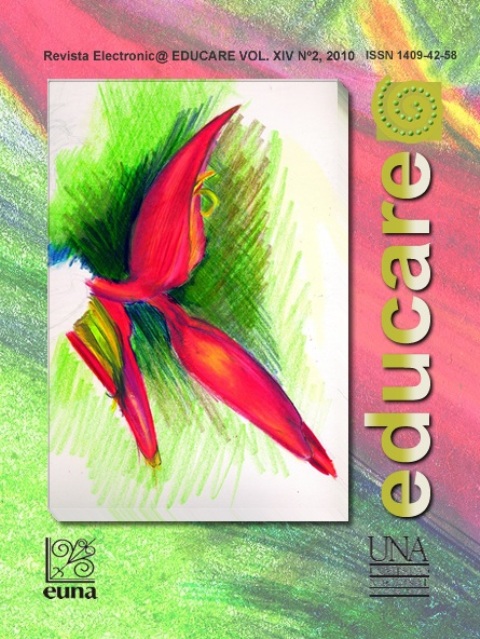The Students’ Perspective of Geometry Teaching and Learning in High School
DOI:
https://doi.org/10.15359/ree.14-2.9Keywords:
teaching, learning, geometry, studentsAbstract
The purpose of this article is to present the results obtained from a questionnaire applied to Costa Rican high school students, in order to know their perspectives about geometry teaching and learning. The results show that geometry classes in high school education have been based on a traditional system of teaching, where the teacher presents the theory; he presents examples and exercises that should be solved by students, which emphasize in the application and memorization of formulas. As a consequence, visualization processes, argumentation and justification don’t have a preponderant role. Geometry is presented to students like a group of definitions, formulas, and theorems completely far from their reality and, where the examples and exercises don’t possess any relationship with their context. As a result, it is considered not important, because it is not applicable to real life situations. Also, the students consider that, to be successful in geometry, it is necessary to know how to use the calculator, to carry out calculations, to have capacity to memorize definitions, formulas and theorems, to possess capacity to understand the geometric drawings and to carry out clever exercises to develop a practical ability.
References
Abrate, R.; Delgado, G. y Pochulu, M. (2006). Caracterización de las actividades de Geometría
que proponen los textos de Matemática. Revista Iberoamericana de Educación, 39(1), 1-9.
Recuperado el 22 de octubre de 2007 en http://www.rieoei.org/deloslectores/1290Abrate.pdf
Almeida, M. (2002). Desarrollo Profesional Docente en Geometría: análisis de un proceso de
Formación a Distancia. (Memoria de tesis doctoral). Departamento de Didáctica de las Ciencias
Experimentales y de las Matemáticas. Universidad de Barcelona, Barcelona. Recuperado el 22
de octubre de 2007 en http://www.tesisenxarxa.net/TESIS_UB/AVAILABLE/TDX-1008102-
//TOL119.pdf
Báez, R. & Iglesias, M. (2007). Principios didácticos a seguir en el proceso de enseñanza y
aprendizaje de la geometría en la UPEL “El Mácaro”. Enseñanza de la Matemática, Vols. 12
al 16, Número extraordinario, 67-87.
Barrantes, M. (2004). Recuerdos, expectativas y concepciones de los estudiantes para Maestro
sobre la geometría escolar y su enseñanza-aprendizaje. (Tesis doctoral). Departamento
de Didáctica de las Ciencias Experimentales y de las Matemáticas, Facultad de Educación,
Universidad de Extremadura. España.
Barrantes, M. y Blanco, L. J. (2004). Recuerdos, expectativas y concepciones de los estudiantes para
Maestro sobre la geometría Escolar. Enseñanza de las Ciencias 22(2), 241-250.
Barrantes, M. y Blanco, L. J. (2005). Análisis de las concepciones de los profesores en formación
sobre la enseñanza y aprendizaje de la geometría. Números, 62, 33-44.
Castiblanco, A., Urquina, H., Camargo, L. y Acosta, M. (2004). Pensamiento Geométrico y
Tecnologías Computacionales. Colombia: Ministerio de Educación Nacional. Enlace Editores
Ltda.
Costa Rica. Ministerio de Educación Pública. (2005). Programas de estudio de Matemática. III
Ciclo. San José, Costa Rica.
Gamboa, R. y Morales, Y. (2008). Alcances y precauciones sobre el uso de software de geometría
dinámica tipo constructivo-deductivo. Memoria del X Evento Internacional MATECOMPU
[Memoria digital en CD]. Matanzas, Cuba.
Goncalves, R. (2006, Enero-Junio). ¿Por qué los estudiantes no logran un nivel de razonamiento en
la geometría? Revista Ciencias de la Educación, 1(27), 83-98.
Hernández, V. & Villalba, M. (2001). Perspectivas en la Enseñanza de la geometría para el
siglo XXI. Documento de discusión para estudio ICMI. PMME-UNISON. Traducción del
documento original. Recuperado el 18 de octubre de 2007 en http://www.euclides.org/menu/
articles/article2.htm
Jones, K. (2002). Issues in the Teaching and Learning of Geometry. En L. Haggarty (Ed.), Aspects
of Teaching Secondary Mathematics. Perspectives on practice (pp. 121-139). London:
RoutledgeFalmer.
National Council of Teachers of Mathematics [NCTM]. (2000). Principles and standards for school
mathematics. Reston, VA: National Council of Teachers of Mathematics.
Torregosa, G. & Quesada, H. (2007, Julio). Coordinación de procesos cognitivos en Geometría.
Revista Latinoamericana de Investigación en Matemática Educativa, 10(2), 275-300.
Downloads
Additional Files
Published
How to Cite
Issue
Section
License
1. In case the submitted paper is accepted for publication, the author(s) FREELY, COSTLESS, EXCLUSIVELY AND FOR AN INDEFINITE TERM transfer copyrights and patrimonial rights to Universidad Nacional (UNA, Costa Rica). For more details check the Originality Statement and Copyright Transfer Agreement
2. REUTILIZATION RIGHTS: UNA authorizes authors to use, for any purpose (among them selfarchiving or autoarchiving) and to publish in the Internet in any electronic site, the paper´'s final version, both approved and published (post print), as long as it is done with a non commercial purpose, does not generate derivates without previous consentment and recognizes both publisher's name and authorship.
3. The submission and possible publication of the paper in the Educare Electronic Journal is ruled by the Journal’s editorial policies, the institutional rules of Universidad Nacional and the laws of the Republic of Costa Rica. Additionally, any possible difference of opinion or future dispute shall be settled in accordance with the mechanisms of Alternative Dispute Resolution and the Costa Rican Jurisdiction.
4. In all cases, it is understood that the opinions issued are those of the authors and do not necessarily reflect the position and opinion of Educare, CIDE or Universidad Nacional, Costa Rica. It is also understood that, in the exercise of academic freedom, the authors have carried out a rogorous scientific-academic process of research, reflection and argumentation thar lays within the thematic scope of interest of the Journal.
5. The papers published by Educare Electronic Journal use a Creative Commons License:















 The articles published by Educare Electronic Journal can be shared with a Creative Commons License:
The articles published by Educare Electronic Journal can be shared with a Creative Commons License: 



